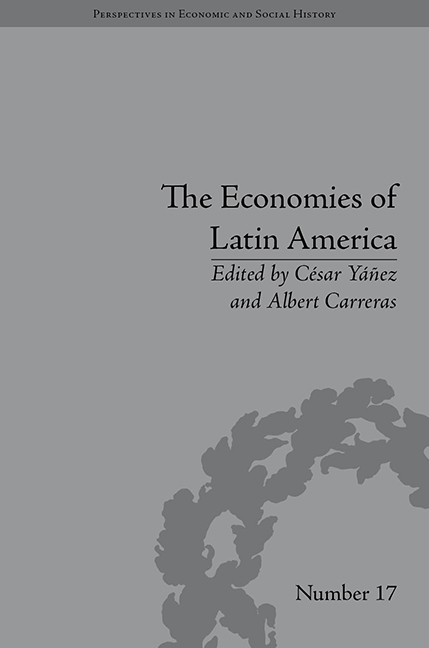Book contents
- Frontmatter
- CONTENTS
- List of Figures and Tables
- List of Contributors
- Preface
- Introduction: Latin American Economic Backwardness Revisited
- 1 Expectations, Institutions and Economic Performance: Latin America and the Western European Periphery during the Twentieth Century
- 2 On the Accuracy of Latin American Trade Statistics: A Non-Parametric Test for 1925
- 3 Latin America and Its Main Trade Partners, 1860–1930: Did the First World War Affect Geographical Patterns?
- 4 The Structure of Latin American Investment in Equipment Goods during the Mature Period of the First Globalization
- 5 Factorial Distribution of Income in Latin America, 1950–2000: New Series from the National Account Data
- 6 The Influence of the First World War on the Economies of Central America, 1900–29: An Analysis From a Foreign Trade Perspective
- 7 Economic Modernization in Adverse Institutional Environments: The Cases of Cuba and Chile
- 8 Capital Goods Imports, Machinery Investment and Economic Development in the Long Run: The Case of Chile
- 9 The Sugar Industry, the Forests and the Cuban Energy Transition, from the Eighteenth Century to the Mid-Twentieth Century
- 10 Empirical Debate on Terms Of Trade and the Double Factorial Terms of Trade of Colombia, 1975–2006
- 11 Public Revenues in Bolivia, 1900–31
- 12 The Consumption of Durable Goods in Latin America, 1890–1913: Analysis and Estimation of a Demand Function
- Notes
- Index
1 - Expectations, Institutions and Economic Performance: Latin America and the Western European Periphery during the Twentieth Century
- Frontmatter
- CONTENTS
- List of Figures and Tables
- List of Contributors
- Preface
- Introduction: Latin American Economic Backwardness Revisited
- 1 Expectations, Institutions and Economic Performance: Latin America and the Western European Periphery during the Twentieth Century
- 2 On the Accuracy of Latin American Trade Statistics: A Non-Parametric Test for 1925
- 3 Latin America and Its Main Trade Partners, 1860–1930: Did the First World War Affect Geographical Patterns?
- 4 The Structure of Latin American Investment in Equipment Goods during the Mature Period of the First Globalization
- 5 Factorial Distribution of Income in Latin America, 1950–2000: New Series from the National Account Data
- 6 The Influence of the First World War on the Economies of Central America, 1900–29: An Analysis From a Foreign Trade Perspective
- 7 Economic Modernization in Adverse Institutional Environments: The Cases of Cuba and Chile
- 8 Capital Goods Imports, Machinery Investment and Economic Development in the Long Run: The Case of Chile
- 9 The Sugar Industry, the Forests and the Cuban Energy Transition, from the Eighteenth Century to the Mid-Twentieth Century
- 10 Empirical Debate on Terms Of Trade and the Double Factorial Terms of Trade of Colombia, 1975–2006
- 11 Public Revenues in Bolivia, 1900–31
- 12 The Consumption of Durable Goods in Latin America, 1890–1913: Analysis and Estimation of a Demand Function
- Notes
- Index
Summary
Introduction
My hypothesis is that the increasing difficulties found by Latin American and Caribbean (LA&C) governments to promote growth enhancing policies via foreign trade during the first half of the twentieth century completely changed their system of incentives. Until quite late – for the smallest countries until the late 1940s – they hoped for the return of the old free trade order. The agreements reached at Bretton Woods – with a strong Latin American presence – were highly promising for all of them. The disappointment over the failure to launch the Organization of International Trade was enormous. While in the aftermath of the Second World War western European countries were able to expand their markets, to build a full employment consensus and to keep under control the challenge of the communist parties and the popular attraction of the Soviet Union, Latin American and Caribbean countries had to contend with the shrinking of their markets without any clear explanation as to why they were shrinking. The only reason was the opportunistic behaviour of the developed countries, taking advantage of the Cold War series of exceptions to the Bretton Woods agreements. I use the European southern peripheral countries as a counter-example.
If everybody in the literature accepts the importance of the ‘carrot’ for post Second World War western Europe, what could be the importance of the ‘stick’ for Latin America? In my view, the diminished expectations that were increasingly built from the 1920s to the 1940s fuelled the decline of Latin American institutions.
- Type
- Chapter
- Information
- The Economies of Latin AmericaNew Cliometric Data, pp. 19 - 40Publisher: Pickering & ChattoFirst published in: 2014



